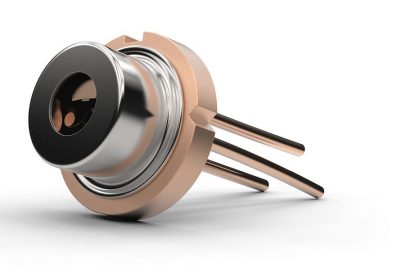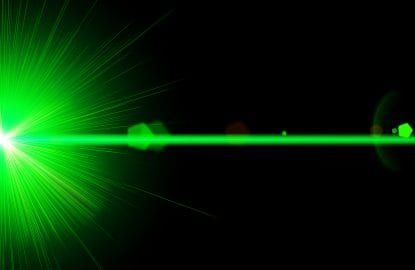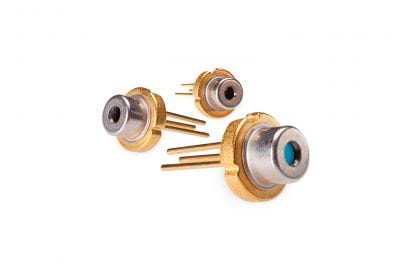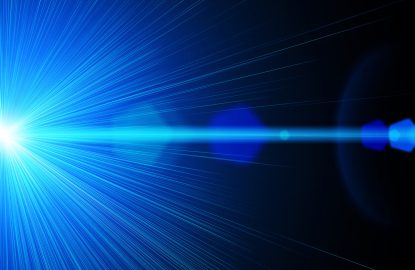A laser diode is a laser where the active medium is a semiconductor device. A laser diode is a specific type of light-emitting diode, in which a high proportion of the light generated in the semiconductor chip is reflected by partially reflecting mirrors at each end of the chip so that its intensity builds up. When the intensity is sufficiently high, the interaction of the light with the semiconductor material causes more light to be generated. This is the onset of laser operation. Laser diodes are always used with electronics to control the light output. Electronics can be integrated as a standalone laser module or as part of a larger system.
Laser diodes are current-controlled rather than voltage-controlled devices. The electrical characteristics of the laser diode result in a voltage across the diode and that voltage is dependent on wavelength, optical power, and the type of laser diode.
Factors That Affect Laser Diode Operation
Temperature
Environmental temperature as well as the temperature rise that results from the electrical power dissipation in the laser diode itself can affect laser diode operation. The light conversion efficiency is not 100%, so there is always electrical power that is converted into heat. Because the laser diode semiconductor chip is very small, this heat could cause it to reach a very high temperature, destroying its semiconductor and optical properties. Therefore it is essential to remove and manage the heat produced. The temperature rise of the laser diode adds to the environmental temperature. Both are important and have to be controlled.
Electrical current
The electrical current is directly related to the amount of light emitted from the laser diode. There is a threshold current below which the laser diode behaves like an LED, producing incoherent light in random phases over a narrow range of wavelengths (typically 50nm). Above the threshold, the light produced is amplified internally, causing the emitted light to become coherent with all emitted photons being in phase. Also the emitted spectrum becomes much more monochromatic (typically less than 5nm wide). This is the onset of laser operation. Once the threshold current is exceeded, there is usually an almost linear relationship between the current and the light output.
Voltage & Wavelength
The voltage appears across the laser diode as a result of the current flowing through it. This voltage is dependent on its wavelength. Typically, the voltage that appears with red and infrared wavelength diodes is between 1.5V and 3V but for green, blue, and ultraviolet the voltage is often above 5V. There is a distinct step dependent on wavelength.
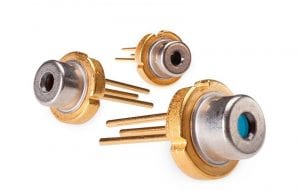
Voltage and Laser Diodes
It is important to understand the voltage requirements of the laser diode to ensure that the drive electronics are capable of controlling it properly. For instance, one very critical parameter is the reverse voltage that a laser diode can tolerate. Laser diodes are extremely sensitive to reverse voltage and it is always necessary to take precautions when handling them to prevent static electricity from causing damage. Unlike other semiconductor diodes, the damage threshold can be as low as 2V. Additionally, the design of the drive circuit must ensure that no reverse voltage can be applied to the laser diode under any circumstances. Furthermore, because this is a semiconductor diode, forward voltage is usually logarithmically related to current. If voltage is allowed to exceed a safe level and the current is not limited by the drive circuit, the diode current can exceed its maximum current rating. Under these conditions, the light output becomes so large that the reflective surfaces become damaged, there is a consequential dramatic loss of efficiency and the laser diode becomes useless. Both the reverse and forward voltage need to be managed carefully.
Voltage and the p-n junction in laser diodes
Electrically a laser diode is built around a typical semiconductor p-n junction. The material properties of the p-n junction itself are such that light is emitted as current flows across the junction. Electrons flowing across the junction recombine with holes, each emitting a photon in the process. The emitted photons are constrained by the shape, size, and optical properties of the p-n junction and its surrounding structures so that they travel through the junction and are reflected many times by the mirror surfaces at both ends. These photons can interact with electrons crossing the junction. When this happens, the incident photon is absorbed and two photons are released. In this way, the light traveling through the junction is amplified. When the current is sufficient for amplification to overcome losses such as re-absorption and emission from the mirror surfaces, the process becomes self-sustaining and laser action ensues. The wavelength of the photons is determined by the band gap energy, as this energy difference appears as a photon when an electron recombines with a hole. The laser diode voltage is largely determined by the band gap energy, which is why voltage tends to be inversely related to wavelength. However, green laser diodes are a special case.
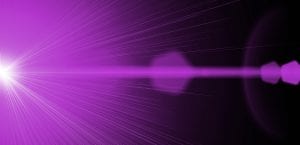
Typical voltage ranges for laser diodes
Voltage ranges differ by wavelength e.g. green laser diodes tend to be higher than blue and UV, and infrared tend to be lower than red. Typical values are 1.8V for infrared, 2.5V for red, and 5V for blue, violet and UV. As mentioned above, green diodes are anomalous with voltages between 5.5V and 8V. Other anomalies will arise for frequency-doubled laser diodes such as those operating at 532nm. Operating voltage for these devices will fall into the range determined by the fundamental frequency, which will usually be in the infrared. Voltage increases slightly with current, and falls with increasing temperature, for all wavelengths. Additionally, there are model-to-model variations depending on the exact structure of the semiconductor chip, and part-to-part tolerance in every case due to variability in the semiconductor fabrication process.
Relationship between voltage and current in laser diode operation
Almost all the voltage generated by a laser diode appears across the p-n junction but there are small contributions due to the resistive properties of the connections between the laser diode terminals and the p-n junction itself. Being a semiconductor diode, if you were to chart voltage against current, forward voltage would rise very sharply as soon as any current flows and then remain relatively constant as the current continues to increase. This is typical semiconductor diode behavior. In the reverse direction, as reverse voltage increases there is a very small current until you reach the breakdown voltage. In laser diodes the breakdown voltage is very low, typically about 2V. This is why the precautions mentioned above must be taken.
Laser Diode Drivers
Laser diode output is determined by current, so the driver circuit will control the current into the laser diode in order to provide the required amount of light output. The driver is in effect a current controller. The range of current that the driver should provide is determined by the laser diode datasheet and the optical requirements – light output, the efficiency of the optics, etc. The driver should control the current while limiting voltage to the appropriate levels under all conditions, including fault conditions. Driver circuits often have additional features such as digital modulation, analog level control and/or analog modulation.
Voltage requirements for different types of laser diodes
As mentioned above, laser diode operating voltage depends on a number of factors including wavelength, current, temperature, model design, and tolerances. All these must be taken into account when designing a driver circuit. The laser diode datasheet should always be used as a reference to establish the voltage range required for the particular application, and adjustments made for actual operating conditions such as temperature and current ranges. In some cases, it may be necessary to measure the characteristics of individual diodes in order to obtain data for sufficiently tight control of voltage.
Laser diode aging
As a laser diode ages, it becomes less efficient, requiring more current to produce the same light output. Current increases gradually during the life of the diode, with end-of-life usually considered to occur when current has increased by 30% of its initial value. The driver circuit must allow for these changes.
The importance of current regulation in laser diode operation
To operate a laser diode, the driver circuit must exceed the threshold current. Above this, the light output is linearly related to the current. For constant light output, the driver will provide constant current at any particular temperature. The current must be adapted to changes in temperature and regulated against changes in supply voltage. If there is modulation, the current must follow the modulation format. The current must not exceed the maximum rated current. Adequate protection against electrostatic discharge, power supply surges and transients must always be included.
User Safety
When designing a laser diode and driver, it is important to understand the system as a whole so that user safety is properly considered.
Laser diodes concentrate light output into an intense beam. In almost all cases, if the laser beam enters the eye even for a short time, permanent blindness may result. Whenever lasers are in use it is essential to take all appropriate safety measures to ensure this cannot happen.
Conclusion
This post has discussed the factors that affect laser diode operation, voltage and current requirements and limits, laser diode driver design and laser safety. For more information on laser diodes, and assistance with driver design, visit https://www.prophotonix.com/led-and-laser-products/laser-diodes/
FAQs:
1. What is the voltage range of a laser diode?
The voltage range of a laser diode depends primarily on its wavelength, tending to be higher for shorter wavelengths.
2. Does the voltage of a laser diode change depending on the type of laser?
A number of factors, including laser diode type, specific model, and part-to-part tolerances, determine the operating voltage.
3. How do I determine the voltage requirements of a specific laser diode?
To determine the voltage requirements for a specific laser diode, it is best to inspect the laser diode datasheet and make adjustments for operating temperature, current, and tolerances.
4. Can a laser diode operate with a constant voltage?
When a diode is operating at constant current and constant temperature the voltage will be constant. Regulating to this voltage will result in constant current provided there is no change in temperature, but this is unsuitable to achieve constant light output because of the aging process. Additionally, practical driver circuits must almost always accommodate some variability of temperature, which results in changing operating voltage. The driver circuit should not be designed to apply a constant voltage because there will always be variations. Aging of the laser diode affects the current. As it becomes less efficient, the increase in current will result in a small increase in voltage at a particular temperature.
5. What is the difference between voltage and current when it comes to laser diodes?
The optical output of a laser diode is directly related to its operating current. Due to its properties as a semiconductor diode, this current results in a voltage across the laser diode terminals.
6. How much voltage is required to turn on a laser diode?
The voltage required to turn on a laser diode depends primarily on the wavelength, the diode type, the current required, and the temperature.
7. What is the maximum voltage that a laser diode can handle?
It is best to refer to the laser diode datasheet to determine the maximum forward voltage under the intended operating conditions and to ensure that the reverse voltage can never exceed the datasheet rating.
8. Can a laser diode be damaged by too much voltage?
Yes, if the reverse voltage exceeds the voltage given in the datasheet the laser diode will almost certainly be harmed. If due to drive circuit failures, unsuitable design or pick up of static charge, the forward voltage exceeds the maximum allowed then the diode can also be damaged.
9. How is the voltage of a laser diode controlled?
When handling a bare diode, voltage is limited by the user’s electrostatic discharge precautions. Once the diode is connected to the driver circuit, laser diode voltage is limited by driver design.
10. Is it possible to power a laser diode with a battery?
Yes, it is possible to power a laser diode with a battery provided that the driver circuit is designed appropriately.
11. Is the voltage of a laser diode related to its power output?
A laser diode is a current-operated device but the effect of the current is to develop a voltage, which changes depending primarily on current and temperature.
12. What are the risks of using incorrect voltage to power a laser diode?
The risk is that the laser diode will be damaged or destroyed. There is an additional risk that high current will flow briefly before the diode fails, resulting in very high output intensity. This may cause blindness if the beam enters the eye.
13. Can a laser diode be powered with an AC voltage source?
The laser diode driver can be powered with an AC voltage source provided that the driver system design includes an AC-to-DC converter.
14. Is it necessary to use a laser diode driver to control the voltage of a laser diode?
Yes, it is essential.

